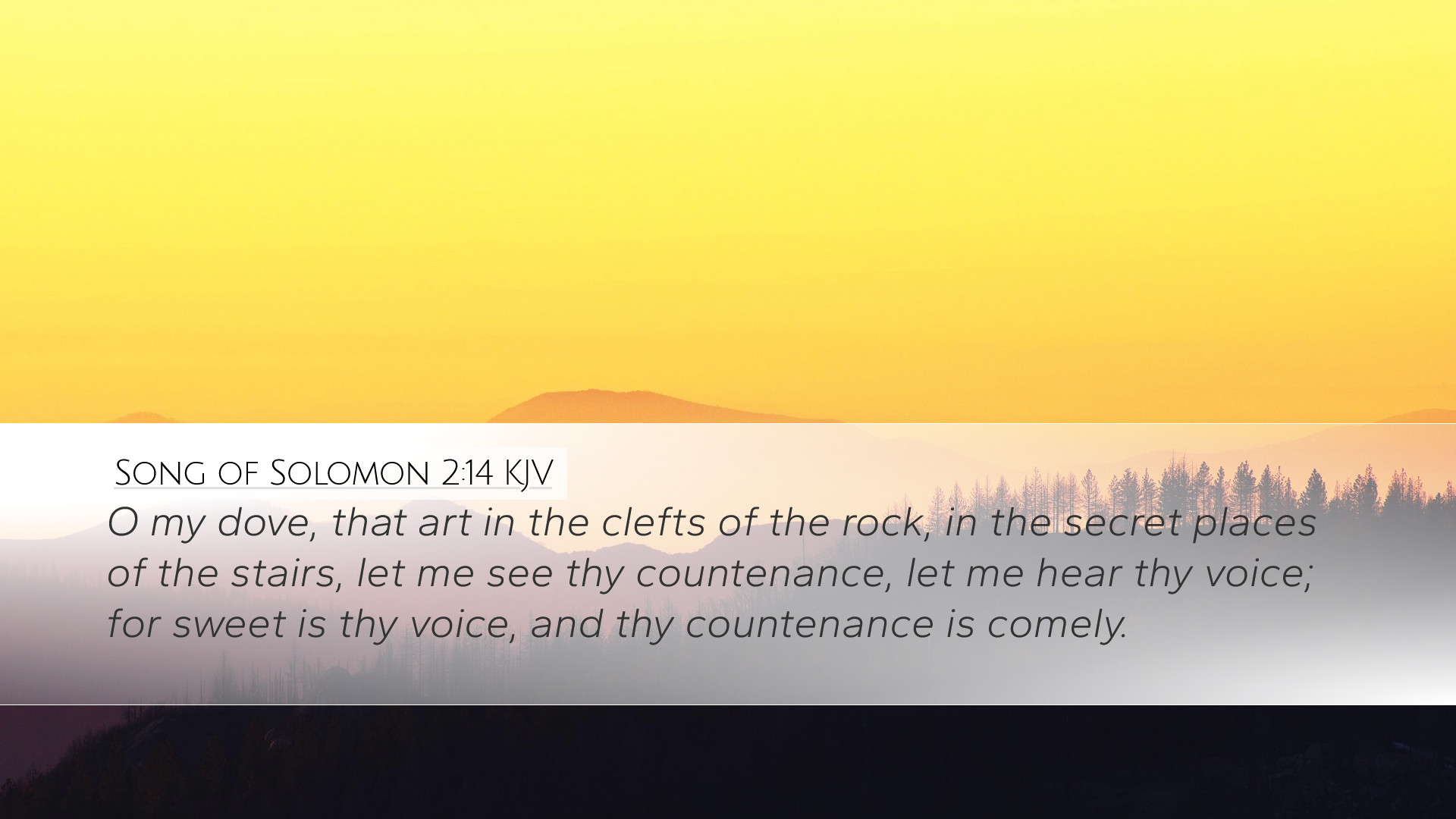Commentary on Song of Solomon 2:14
Verse: "O my dove, that art in the clefts of the rock, in the secret places of the stairs, let me see thy countenance, let me hear thy voice; for sweet is thy voice, and thy countenance is comely."
Introduction
The Song of Solomon, attributed to King Solomon, is one of the most poetic and rich books in the Bible. It has been the subject of various interpretations ranging from literal romantic interpretation to profound allegorical meanings concerning God's love for His people. In this commentary, we will explore Song of Solomon 2:14, examining the implications of the terms used, the metaphors present, and the theological insights offered by notable public domain commentaries such as those by Matthew Henry, Albert Barnes, and Adam Clarke.
Exegesis of the Verse
In this verse, we see a tender call from the beloved (presumably Solomon) to his dove-like lover. The metaphor of the dove conveys purity, gentleness, and affection. The imagery of "clefts of the rock" and "secret places" suggests a place of refuge and intimacy. This leads us to consider the spiritual significance of safety and communion with God.
Key Themes
- Divine Pursuit: The beloved’s call expresses a desire for closeness, mirroring God’s yearning to draw His people to Himself. This reflects the divine pursuit found throughout scripture.
- Intimacy and Relationship: The request to "see thy countenance" indicates not only the desire for physical presence but also the longing for deeper relational intimacy, which can be paralleled to the relationship between Christ and the Church.
- Beauty of the Beloved: The acknowledgment that "thy countenance is comely" emphasizes the inherent beauty that is found in worship and the soul’s engagement with God.
Matthew Henry's Insight
Matthew Henry emphasizes the affection displayed in this verse, pointing out that the love expressed is both earnest and ardent. He argues that the 'dove' symbolizes a peaceful and sensible creature, reflecting the nature of the beloved. Henry notes that the mention of "the clefts of the rock" can be seen as representing Christ as our rock, where believers find shelter and security. He relates this imagery to the challenges faced in life, asserting that the lover is shown to guard and protect those who seek refuge, highlighting God's protective nature over His people.
Albert Barnes' Perspective
Albert Barnes delves into the implications of the “secret places” and posits that these are places where genuine communion occurs, away from the clamor of daily life. He interprets the "voice" as not only the spoken word but also as an expression of emotions and the beauty contained in love. He notes that the emphasis on "sweet is thy voice" suggests that true beauty encompasses both visual and auditory elements, representing how God's voice calls believers into a deeper understanding of His love. Barnes expresses that God desires His people to not only see Him but to engage with Him on all levels of existence.
Adam Clarke's Thoughts
Adam Clarke draws attention to the metaphorical language employed in this verse, indicating that the imagery of the "clefts of the rock" points to an intimate hiding place where love can flourish. Clarke interprets 'the dove' as signifying purity and simplicity, a representation of the faithful soul. He emphasizes the significance of the call to “hear thy voice”; Clarke believes that communication plays a vital role in maintaining relationships, particularly in a covenant relationship with God. Furthermore, Clarke mirrors the concept of communion expressed in scripture where God often calls His people into dialogue and relationship.
Theological Insights
When interpreting Song of Solomon 2:14, it is imperative to understand the broader theological implications. This passage exemplifies a divine romance, portraying how God intimately desires connection with humanity:
- God's Desire for Communion: The consistent call to see and hear can be likened to God’s desire for His people to engage with Him. This interaction is central to the life of faith, transforming believers and drawing them closer to their Creator.
- Understanding of Love: The imagery of the dove and the request for communion reflect the nature of love—symbolizing both vulnerability and strength, which can only come from a true relationship with God.
- Safe Places in God: The secret places mentioned signify more than mere physical locations; they represent the spiritual retreats God offers, where believers can withdraw for intimacy, prayer, and reflection.
Practical Applications
This verse resonates deeply in various applications for personal and congregational life:
- Encouragement in Prayer: The call to hear and see encourages believers to cultivate a robust prayer life, seeking to enter into the intimate spaces with God.
- Celebrating Beauty in Worship: Recognizing God's beauty should inspire churches to foster environments where worship reflects the sweetness and beauty of God's presence.
- Fostering Trust: Just as the dove finds refuge, believers are called to trust in God's sheltering goodness amidst life's trials and uncertainties.
Conclusion
Song of Solomon 2:14 serves as a profound reminder of God's longing for a deepening relationship with His people. Through the words of the beloved, we see a display of affection, care, and an invitation to intimacy. By delving into the insights provided by esteemed commentators, we grasp a more significant understanding of the text that extends beyond romantic love to encompass the essence of God’s redemptive love for humanity. Let us, therefore, respond to this divine call, seeking to dwell in the beauty of His presence and hearing His sweet voice in our lives.


